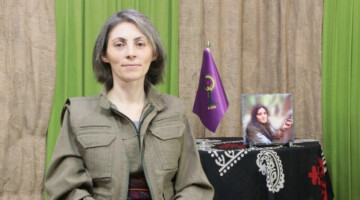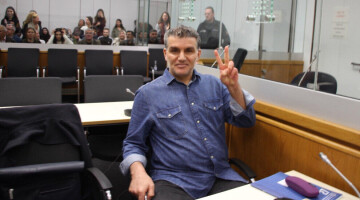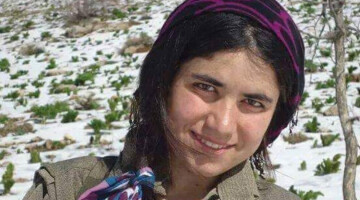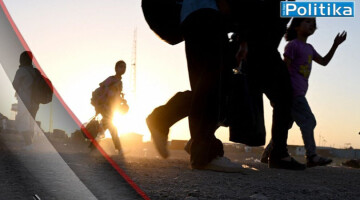The Turkish president last week announced a new "operation" in self-ruled northeastern Syria. The goal, he said, is to create a 30-kilometer-deep "security zone" along the southern border. This is not the first time Ankara has threatened to enforce a so-called buffer zone along Turkey's southern border and Syria's northern border. In the process, all Rojava towns - except Hesekê - are to be brought under Turkish control. The last threat of this kind led to a war of aggression and the occupation of Serêkaniyê (Ras al-Ain) and Girê Spî (Tal Abyad) in October 2019. The local population continues to suffer from the consequences to this day.
The occupation of Serêkaniyê and Girê Spî had been preceded by demands from the Turkish leadership for the establishment of a buffer zone, similar to today. In August 2019, the United States and Turkey agreed on a "peace zone." Part of the agreement included the establishment of a joint operations center on the Turkish-Syrian border. Two months later, the invasion began with the incursion into Serêkaniyê, one of the oldest Kurdish towns. The Turkish state had repeatedly tried to take control of the town since 2012 with the help of Al-Qaeda and ISIS. With the occupation in 2019, a systematic restructuring of the population began.
Since the proclamation of the autonomous administration in 2012, all ethnic and religious identities of Serêkaniyê have lived together in harmony and organized themselves in popular councils. In two and a half years of the Turkish jihadist invasion, hundreds of murders have been committed in the city by the occupiers, and the number of unreported cases is probably many times higher. Conservative estimates put the displacement rate at 85 percent of the original population. Hundreds of thousands of people live in makeshift refugee camps near Ain Issa and elsewhere. In place of the displaced population, Islamists loyal to Erdoğan and their families from other parts of Syria have been settled. The situation in occupied Serêkaniyê and the crimes against humanity there show what a "security zone" means for the Turkish state.
Serêkaniyê under the rule of the Baathists
Serêkaniyê is located east of Girê Spî, west of Dirbesiyê and north of Til Temir. The city is cut by the border and separated from the Ceylanpınar district of Urfa. In the long history of Serêkaniyê, Kurds, Arabs, Syriacs, Chechens, Turkmen, Armenians and Yazidis have settled there and lived together peacefully. The first decisive demographic restructuring came from the Baath regime in 1974. When the Baath regime launched the "Arab Belt" project in Serêkaniyê, as in all of Rojava, the name of the city and the Kurdish villages were Arabized. Arabs were brought to the region from various parts of Syria, new villages were built, and the proportion of Arabs in the population was increased. A significant part of the Christians of Serêkaniyê emigrated to Syrian cities such as Aleppo and Latakia or to Europe even before the civil war in Syria began.
Attack of the Turkish-backed mercenary troops
Even when the civil war began in 2011, there was a significant Christian population, consisting of Syriacs and Armenians, in addition to Muslim and Yazidi Kurds, Arabs, Circassians and Turkmen. When mercenaries from various al-Qaeda factions, along with collaborators from the so-called Kurdish National Council (ENKS), were sent across the border into Serêkaniyê by the Turkish state on November 8, 2012, and fighting began, a new wave of refugees from the city began. The mercenaries, who controlled most of the city, established a regime of terror by the grace of Turkey. A Christian church in the center of the city was occupied by mercenaries, vandalized and turned into a headquarters. Many residents were expelled from Serêkaniyê and forced to flee to Turkey. Turkey aimed to expel the population and had already set up a reception camp for the displaced at the border.
From a still self-governing residential district, residents together with the YPG/YPJ (People’s/Women’s Defense Units) have liberated their town step by step and driven the mercenaries out of Serêkaniyê. Turkey tried to prevent the liberation by launching new waves of attacks. By November 5, 2013, Ankara had launched four major waves of attacks by militiamen. The Turkish government was not content to simply send its mercenaries across the borders and support them with logistics and ammunition. The Turkish army provided fire support to the jihadist mercenaries with tank attacks across the border. Turkey-backed ISIS attacks on the city then began. ISIS carried out many attacks on the villages of Serêkaniyê in 2014-2015 and perpetrated massacres against the civilian population. In the process, the terrorist militia met fierce resistance from the YPG and YPJ. Both units suffered hundreds of casualties in their defensive struggle against the ISIS attacks. In May 2015, the YPG and YPJ liberated the last villages under ISIS control in Serêkaniyê as part of the Şehîd Rûbar Qamişlo offensive. During this time, many people fled the region.
Safe and free life in self-governed Serêkaniyê
In the period between the liberation from Al-Qaeda and ISIS and the occupation by Turkey that began on October 9, 2019, a system of grassroots self-government was established in Serêkaniyê under difficult conditions. The administration of the city was taken over by a people's council, which was organized within the framework of the self-government of Cizîrê Canton proclaimed in 2014. All peoples and faiths that lived in Serêkaniyê found their representation in this assembly. People could freely live their faith in the liberated Christian churches, mosques and Yazidi centers. Agriculture developed and a health academy was established. However, the aggression by Turkish troops across the border never completely stopped. Again and again, civilians lost their lives because of this. But despite these attacks by the Turkish state, Serêkaniyê was a free and safe city. More and more people, attracted by a free and equal life in safety, began to return to the region.
"Security zone": place of massacres and looting
That changed on October 9, 2019. The war of aggression represented the end of security, brotherhood and peace in the region. Serêkaniyê became a place of massacres and torture. According to the Committee for Refuge and Migration, at least 386 civilians were killed in Serêkaniyê, including 48 women and 12 minors, between October 2019 and December 2021. 48 people were murdered by torture, and eleven were even executed in public places. The Turkish state used white phosphorus against the population during the invasion. Such use falls under the ban on chemical weapons. The Human Rights Association of Cizîrê documented 33 fire deaths caused by Turkish phosphorus bombs. Ten of them were members of the Syrian Democratic Forces (SDF). In addition, 232 cases of torture were documented by the end of last year. There is still no trace of 152 abductees. 1,200 stores and workshops and 5,500 houses belonging to the people of Serêkaniyê were confiscated by the occupying forces.
The demographic structure of the city was changed
With the Turkish occupation, 85 percent of the original population of the city fled. The area around Serêkaniyê includes 140 villages. 55 villages with a Kurdish majority are completely abandoned. The villages of Xirbet Cemo, Dawudiyê and about 80 to 90 percent of the villages surrounding Ain Issa have been destroyed and Turkish military bases built in their place. In addition, members of the mercenary alliance "Syrian National Army" (SNA), which is loyal to Turkey, desecrated Yazidi cemeteries in search of valuable grave goods.
Site of the ISIS reorganization
The city of Girê Spî was under the control of jihadists since 2012 and the ISIS terrorist group since June 2014. In February 2015, the SDF launched a liberation offensive named after martyr Rûbar Qamişlo. The two starting points of the large-scale attack were Serêkaniyê and the village of Majdal, southeast of Til Temir. As part of this offensive, Mebrûka, Silûk and Girê Spî were liberated and the cantons of Kobanê and Cizîrê were connected. At the time, Mebrûka, which administratively belonged to Serêkaniyê, played the role of a headquarters for ISIS and received support from Turkey. The YPG and YPJ liberated this place at the greatest sacrifice. After the establishment of the "security zone" in 2019, Mebrûka once again fell to the jihadists. Mebrûka and Serêkaniyê became places of ISIS reorganization.
According to the Cizîrê Human Rights Association and the Association for Flight and Migration, at least 2,000 jihadists and their families have settled in the city and its villages since the occupation of Serêkaniyê. 55 of these families have been identified as ISIS families, the majority originating from Iraq. Many former ISIS jihadists can also be found in the mercenary groups "Sultan Murad Brigade," "Furqat al-Hamza" and "Ahrar al-Sharqiya" deployed in Serêkaniyê.
The ISIS flag is openly displayed
A specific incident that showed the whole world that Serêkaniyê is a safe hinterland for ISIS occurred on October 25, 2020. Following Erdoğan's threats against France over Muhammad cartoons, members of mercenary groups loyal to Turkey gathered in Serêkaniyê and burned a French flag. During the propaganda action, ISIS flags were displayed and corresponding slogans were shouted. Even the governor of Urfa confirmed the display of the black flag.
Attack planned on Sina prison in occupied territory
The confessions of ISIS commander Abdullah Ismail Ahmad, who is currently in pre-trial detention for the attack on Sina Prison in Hesekê last January, also reported the role of occupied Serêkaniyê for ISIS in his statements. Ahmad stated that he received the order for the attack on the detention center, where thousands of ISIS jihadists are held, from the Turkish intelligence service MIT. He said that the "ISIS governor" of Hesekê was located in the occupation zone around Serêkaniyê and Girê Spî and was working with MIT there. Accordingly, the ISIS jihadists who had been freed from prison were also supposed to have been brought to the regions of northern Syria occupied by Turkey.














